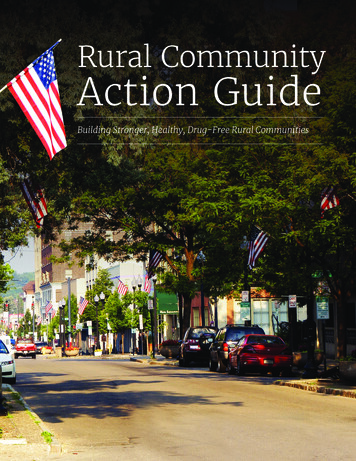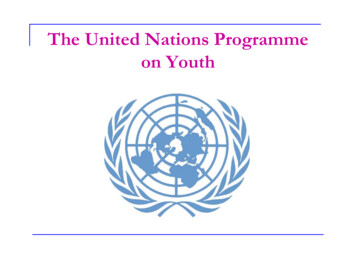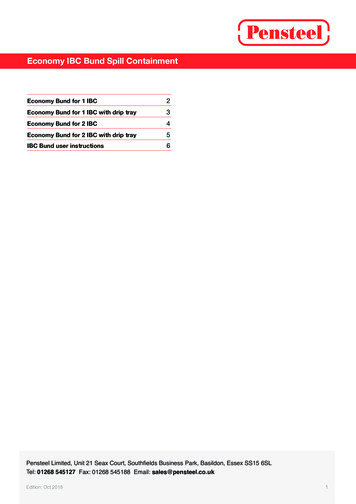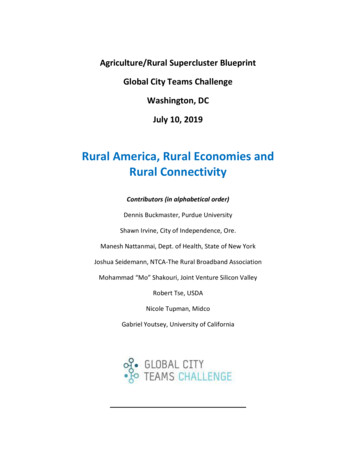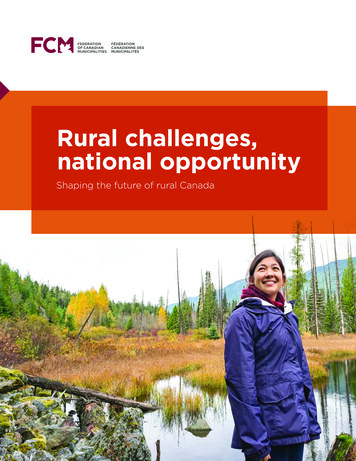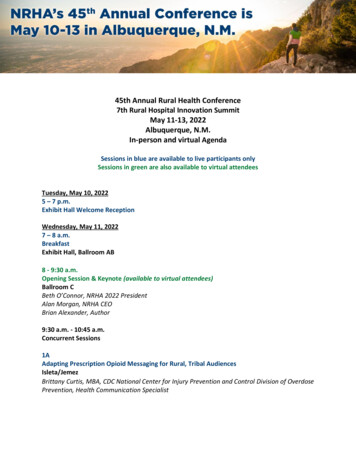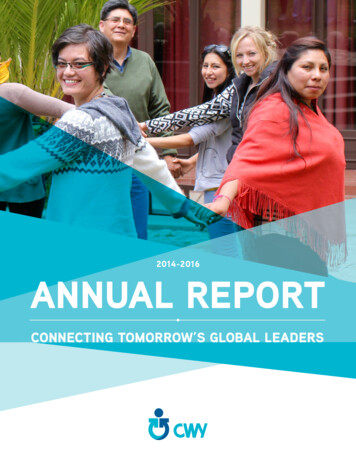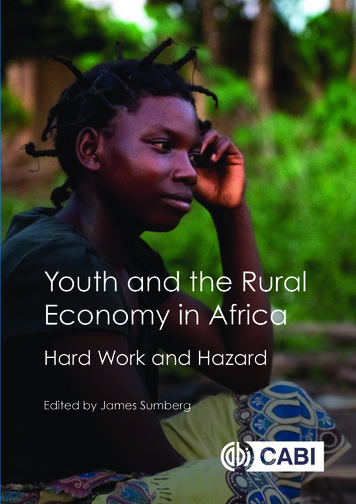
Transcription
Youth and the Rural Economy in Africa: Hard Work and Hazard
Youth and the Rural Economyin Africa: Hard Work and HazardEdited byJames SumbergInstitute of Development Studies (IDS), Brighton, UK
CABI is a trading name of CAB InternationalCABINosworthy WayWallingfordOxfordshire OX10 8DEUKCABI745 Atlantic Avenue8th FloorBoston, MA 02111USATel: 44 (0)1491 832111Fax: 44 (0)1491 833508E-mail: info@cabi.orgWebsite: www.cabi.orgTel: 1 (617)682-9015E-mail: cabi-nao@cabi.orgCAB International, 2021 2021 by CAB International. Youth and the Rural Economy in Africa: HardWork and Hazard is licensed under a Creative Commons AttributionNonCommercial-NoDerivatives 4.0 International LicenseA catalogue record for this book is available from the British Library, London, UK.Library of Congress Cataloging-in-Publication DataNames: Sumberg, J. E. editor.Title: Youth and the rural economy in Africa : hard work and hazard / JamesSumberg.Description: Boston, MA : CAB International, [2021] Includes bibliographicalreferences and index. Summary: “There are many accepted views about therole and position of youth in the African agricultural economy. This bookchallenges those assumptions by analysing new studies, particularly ofgender and social difference. It is a major contribution to current debates anddevelopment policy about youth, agriculture and employment in ruralAfrica”-- Provided by publisher.Identifiers: LCCN 2021005799 (print) LCCN 2021005800 (ebook) ISBN9781789245011 (hardback) ISBN 9781789249828 (paperback) ISBN9781789245028 (pdf) ISBN 9781789245035 (epub)Subjects: LCSH: Agriculture--Economic aspects--Africa. Youth--Africa. Ruraldevelopment--Africa. Africa--Rural conditions.Classification: LCC HD2116 .Y688 2021 (print) LCC HD2116 (ebook) DDC331.3/83096--dc23LC record available at https://lccn.loc.gov/2021005799LC ebook record available at https://lccn.loc.gov/2021005800References to Internet websites (URLs) were accurate at the time of writing.ISBN-13: 978 1 78924 501 1 (hardback)978 1 78924 502 8 (ePDF)978 1 78924 503 5 (ePub)DOI: 10.1079/9781789245011.0000Commissioning editor: David HemmingEditorial assistant: Emma McCannProduction Editor: Marta PatiñoTypeset by SPi, Pondicherry, IndiaPrinted and bound in the UK by Severn, Gloucester
ContentsContributors ixAcknowledgements xiAbbreviations xiii1African Youth and the Rural Economy: Points of Departure 1James Sumberg, Justin Flynn, Marjoke Oosterom, Thomas Yeboah, BarbaraCrossouard and Dorte ThorsenIntroduction 1Policy Narratives 2What they are and why they matter 2Key narratives about rural youth in sub-Saharan Africa 3The Argument 8Conceptual Grounding 8Generational and life course perspectives on youth 9School and education 10Mobility 11Imagined futures, future selves, aspirations 11Opportunity structures, agency, hazard and performance 12Rural economic geography and engagement with the rural economy 13Chapter Summaries 15Notes 17References 172Empirical Windows on African Rural Youth 23Marjoke Oosterom, Jordan Chamberlin and James SumbergIntroduction 23Empirical Windows: How Do We Know About Rural Youth in Africa? 24Studies with a primarily quantitative orientation 25Studies with a primarily qualitative orientation 28Mixed methods studies 30 v
viContentsApproaches and Methods That Underpin This Book 31General approach 31Quantitative data 31Qualitative data 32Conclusions: Toward a Stronger Empirical Base 35Notes 37References 37Appendix 413Are Africa’s Rural Youth Abandoning Agriculture? 43Justin Flynn and James SumbergIntroduction 43Changing Rural Economies 44The what and the where of rural economic activity 44Linkages 44Changing livelihoods 45Structural transformation 46Method 47Youth in the Rural Economy 47Insights from existing quantitative work 47Engagement with the rural economy: three segments 49Discussion 53References 544Young People and Land 58Jordan Chamberlin, Felix Kwame Yeboah and James SumbergIntroduction 58Young People’s Access to Land 58Access is increasingly difficult 58Commodification of land is particularly relevant for young people 61 Changes in farm structure are associated with evolving ruraleconomic opportunities 70Land Access is a Key Conditioner of Other Processes 71Opening New Empirical Windows on to Remaining Knowledge Gaps 73Conclusions 74Notes 74Acknowledgements 74References 755Mobility and the Rural Landscape of Opportunity 78Dorte Thorsen and Thomas YeboahIntroduction 78Youth Mobilities, Transitions and Life Projects 79Mobility, education and work 79Social networks 81Rural Youth Mobilities and Livelihood Building 81Involuntary relocations 81Relocation for education 83Relocations for work 86Discussion and Conclusions 88References 89
Contentsvii6Are Young People Transforming the Rural Economy? 92Jordan Chamberlin and James SumbergIntroduction 92Change in Rural Economies 93Young people as agents of change 93Farming: the challenge of seeing the innovation through the difference 94Evidence from technology adoption studies 95Empirical Windows on Young Farmers: Data and Measurement Challenges 95Do the Young Farm Differently? Available Empirical Evidence 97Discussion 110Conclusions 111Notes 111References 112Appendix 1157The Social Landscape of Education and Work in Rural Sub-Saharan Africa 125Barbara Crossouard, Máiréad Dunne and Carolina SzypIntroduction 125Education and Work 125Education inequalities 126Policy perspectives on education and work 126Contextualizing education and work 128Research Contexts 129Research Methodology 130Research Findings 131The value of education to rural youth 131Schooling and work in the rural economy 132The gendered landscape of education and work 134Conclusions: The Inequalities of Schooling and Work 136Notes 137References 1378Are Rural Young People Stuck in Waithood? 141Marjoke OosteromIntroduction 141Waithood: The Debate 142Honwana’s concept 142Agency, rural livelihoods and social markers of adulthood 143Too Busy to Wait 145Work 145Marriage and family life 147Active citizenship 150Conclusions: Claim Making and Waithood Negotiation 151Note 152References 1529Young People’s Imagined Futures 155Thomas Yeboah, Barbara Crossouard and Justin FlynnIntroduction 155Framing Young People’s Imagined Futures 156
viiiContentsMethods 158The Imagined Futures of Rural Young People 158Expanding and/or diversifying current economic activities 158Accumulating wealth or assets 161Further education and obtaining a professional or salaried job 162Moving from the present to the future 163Discussion and Conclusions 165Notes 166References 166Appendix 16910 Young People and the Rural Economy: Syntheses and Implications 173James Sumberg, Carolina Szyp, Thomas Yeboah, Marjoke Oosterom, BarbaraCrossouard and Jordan ChamberlinIntroduction 173Synthesis 173Implications 175Issues framing and discourse 175Implications for policy 176Implications for research 178Practice 179References 179Index 181
ContributorsChamberlin, Jordan, International Maize and Wheat Improvement Center (CIMMYT), Nairobi,Kenya. E-mail: j.chamberlin@cgiar.orgCrossouard, Barbara, University of Sussex, Brighton, UK. E-mail: b.crossouard@sussex.ac.ukDunne, Máiréad, University of Sussex, Brighton, UK. E-mail: mairead.dunne@sussex.ac.ukFlynn, Justin, Institute of Development Studies (IDS), Brighton, UK. E-mail: j.flynn2@ids.ac.ukOosterom, Marjoke, Institute of Development Studies (IDS), Brighton, UK. E-mail: m.oosterom@ids.ac.ukSumberg, James, Institute of Development Studies (IDS), Brighton, UK. E-mail: j.sumberg@emeritus.ids.ac.ukSzyp, Carolina, Institute of Development Studies (IDS), Brighton, UK. E-mail: c.szyp1@ids.ac.ukThorsen, Dorte, Institute of Development Studies (IDS), Brighton, UK. E-mail: d.thorsen@ids.ac.ukYeboah, Felix Kwame, Michigan State University (MSU), East Lansing, MI, USA. E-mail: yeboahfe@msu.eduYeboah, Thomas, Bureau of Integrated Rural Development (BIRD), Kwame Nkrumah University ofScience and Technology (KNUST), Kumasi, Ghana. E-mail: thomas.yeboah@knust.edu.gh ix
AcknowledgementsIn addition to the chapter authors, many other individuals contributed to Youth and the Rural Economy in Africa: Hard Work and Hazard.First and foremost, we are deeply grateful to the hundreds of young people, and others, whotook the time to participate in the research.Field work was expertly led by Dr Victoria Flavia Namuggala (Makerere University, Uganda),Prof. Okello Uma Ipolto (Gulu University, Uganda), Dr Mamo Hebo Wabe (Addis Ababa University,Ethiopia), Dr Fekadu Adugna Tufa (Addis Ababa University, Ethiopia), Dr Bela Teeken (InternationalInstitute for Tropical Agriculture, Nigeria), Dr Tessy Madu (National Root Crops Research Institute,Nigeria) and Dr Affoué Philomène Koffi (Université Félix Houphouët-Boigny, Côte d’Ivoire). In eachcountry these individuals worked with one or more teams of field researchers, and their dedicationthroughout the research process is very gratefully acknowledged.Dr Hailemariam Ayalew, Dr Kibrom Abay and Ms Woinishet Asnake made valuable contributions to the analysis of LSMS–ISA data.Prof. Agnes Andersson Djurfeldt, Dr Keetie Roelen and Prof. Rachel Sabates-Wheeler providedvaluable reviews of draft chapters.The research was undertaken with grants from the International Fund for Agricultural Development (IFAD), the Agricultural Policy Research in Africa programme (APRA) (funded by the UKDepartment for International Development, DFID), and the MasterCard Foundation; their support isgratefully acknowledged. The opinions expressed here belong to the authors, and do not necessarilyreflect the views or policies of these funders.Finally, without the support and critical eye of Dr Christine Okali, this book would never haveseen the light of day. xi
AMDGsMSUNCENGOPLERALSSAPsSDGsSISSASURSWTSAlliance for a Green Revolution in AfricaAgricultural Policy Research in Africa programmeBrevet d’Etudes du Premier CycleBureau of Integrated Rural Development, Kumasi, GhanaInternational Maize and Wheat Improvement Center, Nairobi, KenyaZambian Central Statistical OfficeUK Department for International Developmentfocus group discussionFast Track Land Reform Programmegross domestic producthuman capital theoryIndaba Agricultural Policy Research Instituteinformation and communications technologiesinternally displaced personsInstitute of Development Studies, Brighton, UKInternational Fund for Agricultural DevelopmentInternational Labour OrganizationInternational Monetary Fundinformation technologyKwame Nkrumah University of Science and Technology, Kumasi, GhanaLord’s Resistance ArmyLiving Standards Measurement Study – Integrated Surveys on AgricultureMillennium Development GoalsMichigan State UniversityNigeria Certificate in Educationnon-governmental organizationPrimary Leaving ExamRural Agricultural Livelihood SurveyStructural Adjustment ProgrammesSustainable Development Goalssustainable intensificationsub-Saharan Africaseemingly unrelated regressionsSchool-to-Work-Transition Surveys xiii
1African Youth and the Rural Economy:Points of DepartureJames Sumberg1, Justin Flynn1, Marjoke Oosterom1, Thomas Yeboah2,Barbara Crossouard3 and Dorte Thorsen11Institute of Development Studies, Brighton, UK; 2Bureau of Integrated RuralDevelopment (BIRD), Kwame Nkrumah University of Science and Technology(KNUST), Kumasi, Ghana; 3University of Sussex, Brighton, UKIntroductionHow do young people across Africa engage withthe rural economy? What are the implications ofthis engagement for their efforts to build theirlivelihoods, and for their futures, for society andfor rural areas? These are the questions thatmotivate this book and the research that underpinsit. Such questions will be of interest to researchers,policy makers, development professionals andothers concerned with the well-being and aspirations of young people, with their search foremployment and decent work, and with therelationship between schooling and work. Individuals working on rural poverty and food security,agriculture and rural development – and ruraltransformation more broadly – should certainlybe interested in rural young people’s lives andlivelihoods, and the futures they imagine forthemselves. Finally, a more nuanced understanding of young people’s engagement with therural economy can help to ground debates aboutdemographic change, including migration andurbanization, and provide a much needed realitycheck of common assumptions and narrativesconcerning youth, conflict and radicalization.The fact that a number of these sameconcerns – including education, decent workand migration – are integral to the SustainableDevelopment Goals (SDGs), and that several ofthe SDGs speak directly to the situation of youth,demonstrates the central place that youngpeople have come to occupy in developmentdebates and policy. Indeed, there is a growingbody of youth- focused scholarship, policy analysis, implementation guidance and programmeevaluations – as well as a plethora of youthtargeted development initiatives. Taken together,these suggest that youth in rural Africa arebeing taken seriously, and it appears that thisfocus will continue well into the future. Whetherthey are being taken seriously for the rightreasons, and whether they are well served by thepolicy and development investments made intheir name, are important points of debate.The book’s ambition is to advance the understanding of young people as social and economicactors in rural Africa. It does this through newempirical analyses, both quantitative and qualitative, involving a significant number of ruralyoung people across multiple countries. Thesenew analyses are brought to bear on the narratives and debates that frame and channel muchof the current interest in youth-specific policyand investment.At this point, readers might be asking themselves, ‘With the recent publication of CreatingOpportunities for Rural Youth (IFAD, 2019) andYouth and Jobs in Rural Africa: Beyond StylizedFacts (Mueller and Thurlow, 2019), do we really CAB International 2021. Youth and the Rural Economy in Africa: Hard Work and Hazard (ed. J. Sumberg) DOI: 10.1079/9781789245011.0001 1
2J. Sumberg et al.need another book on African rural youth?’ Ourresponse is an emphatic ‘Yes’, based primarilyon the fact that neither of these two works bringthe histories, lives, voices or imagined futures ofrural youth into the equation. Youth and theRural Economy in Africa: Hard Work and Hazardbegins to address this critical lacuna.To allow the voices of young people to emerge,this book both starts with different questionsand draws from an expanded set of intellectualand conceptual traditions, and data sources. Forexample, the first question Mueller et al. (2019)pose in Youth and Jobs in Rural Africa: Beyond Stylized Facts is, ‘Are rural youth active participantsin the national growth process?’ They go on toask how their involvement in agricultural technology adoption, rural income diversificationand urban migration ‘affect rural transformation’ (Mueller and Thurlow, 2019, p.3). It isclear from this that while the book investigates‘the role of rural youth in sub-Saharan Africa’s(SSA) development’ (Mueller and Thurlow,2019, p.3), the primary interest is in nationalgrowth processes and rural transformation, notyouth. This explains the prominence given toTimmer’s four-stage model of agricultural transformation (Timmer, 1988) and the striking absence of any theoretical or conceptual treatmentof youth as social and economic actors. Muellerand Thurlow (2019) and IFAD (2019) rely almostexclusively on survey data collected through exercises that generally were not designed with aparticular youth focus in mind.In contrast, in Youth and the Rural Economyin Africa: Hard Work and Hazard we start with thesimple question, ‘What are rural young peopledoing?’ In placing their actions, and their viewsabout those actions, at centre stage, we make noassumptions about what they should be doing,how or where they should be doing it, or whattheir motivations should be. This is not to saythat we approached the research without preconceptions or hypotheses – indeed, as willbecome clear, we draw on a wide array of conceptual insights and disciplinary approaches. Whilenot abandoning microeconomic analyticalframeworks and survey data analysis, we havemade a conscious effort to bring these togetherwith relevant literature from the broader socialsciences including anthropology, sociology, socialgeography, youth studies, gender studies, education and policy studies, and with a wider range ofdata and modes of analysis. In so doing we havesought to grapple with the heterogeneity – ofrural areas, family contexts and young people –which is still largely overlooked by the majorityof policy-oriented analyses.This chapter proceeds as follows. The nextsection situates the current interest in Africa’srural youth, and the place of this book, withinthe broader discussion of policy narratives. Itthen identifies seven narratives about ruralyouth in SSA that channel much contemporarypolicy and development intervention. Followingthis the argument that runs through the book isoutlined. The key conceptual resources that thevarious chapters draw upon are briefly introduced in the following section. The last sectionprovides a brief summary of each of the subsequent chapters.Policy NarrativesWhat they are and whythey matterAs with all policy problems, policy and interventions relating to rural youth in SSA are builtaround narratives or stories (Roe, 1991, 1995;Jones and McBeth, 2010). Narratives are centralto policy processes, serving as an important vehicle for organizing and communicating policyinformation (Shanahan et al., 2011). They setout the problem, explain why it has arisen andpropose how it should be addressed. A successfulpolicy narrative – one that is memorable, taken upand integrated into policy and public discourse –cuts through complexity and heterogeneity, andsets nuance aside. In this way it provides a compelling and powerful framing, a justification andcall to arms. It is particularly important to notethat a successful narrative will foreground certain solutions or interventions (or developmentpathways), while explicitly or implicitly delegitimizing others.Narratives provide a lens through which toview and make sense of a complex and perhapsthreatening problem. Successful, compelling narratives are often constructed around a memorable word or phrase: for example, phrases like‘youth bulge’, ‘demographic dividend’, ‘farmingas a business’, ‘digital native’ and ‘waithood’ are at
African Youth and the Rural Economy: Points of Departurethe core of the key narratives about rural youth inSSA. Narratives are about communication andpersuasion, and they are acutely political. Theyare constructed, disseminated and used with theaim of promoting a particular perspective on aproblem and a set of preferred solutions. As such,a narrative will serve or advance the interests ofsome individuals, groups and coalitions, whileseeking to thwart the interests of other actors.Policy narratives can be thought of asdominant (hegemonic) or alternative (emergent). However, it is usually not useful to thinkof them as true or false, right or wrong. Aroundall important development issues – like ruralyouth in SSA – there is just too much heterogeneity, too many unknowns and too manylegitimate differences in perspective, for anynecessarily simplistic narrative to be true in allor most contexts. Ultimately, this does not matter because the job of a narrative is not to convey truth, but to be believable, to stimulate andfacilitate a policy response, and to promote certain responses over others. It is neverthelessimportant to critically examine policy narratives with the aim of understanding, for example, how they foreground or backgrounddifferent groups (e.g. male or female youth) in avariety of rural situations (e.g. high or lowpotential areas), and how they drive policy responses in particular directions (e.g. toward theyouth themselves and away from structuralproblems). How narratives are used to advancethe interests of some groups over others is aparticularly important area for research.Specifically, this book, with its focus onyouth in the rural economy, is interested in(i) how dominant narratives align with the different realities of young people’s lives in a rangeof rural contexts; (ii) how they promote certainpossible responses and close down discussion ofothers; and (iii) the politics around their use.This approach to development narratives is different from fact checking, ‘myth busting’ or‘telling myth from fact’ (Christiaensen, 2017;Christiaensen and Demery, 2018; Mabiso andBenfica, 2019). While these exercises are alsoimportant, they often fail to appreciate the political nature of policy narratives, and that inpolicy processes, ‘a good narrative is worth athousand facts’.The relationship between narrative andevidence is complex and often awkward: an3evidence-based narrative is not necessarily themost desirable or the most powerful tool. Toomuch attention to the detail and nuance of theevidence, the sense that every individual story orvillage is unique, makes it impossible to constructa strong narrative. This is why ‘essentialism’ is atthe core of the most powerful policy narratives.Phillips (2010, p.47) defines essentialism as ‘theattribution of certain characteristics to everyone subsumed within a particular category’. Inthe narratives addressed in this book, essentialism is expressed through statements like ‘Africanyouth are ’, ‘rural areas in SSA are ’, ‘agriculture in SSA is ’ and ‘Africa’s youth bulge is ’.Essentialism is de rigueur for a compelling policynarrative, but it provides a very poor basis forevidence generation, policy development orinvestment decisions.As will become apparent, and despite the recent upsurge in published work, there is little direct evidence with which to cleanly interrogate someof the most important narratives around youthand the rural economy. The challenge is magnifiedby a lack of clarity around key concepts and categories (i.e. ‘youth’, ‘migration’ and ‘aspirations’),and the considerable heterogeneity both amongyoung people and rural spaces. A closely relatedchallenge is that because the evidence base is sopatchy, research findings from a detailed study in aparticular setting can subsequently be projectedacross an entire region, country or the wholesubcontinent. While nationally representativehousehold survey data address some concerns(see Chapter 2, this volume), they also raiseothers (Carletto and Gourlay, 2019).Key narratives about rural youthin sub-Saharan AfricaDebate about, and actions to address, the challenges associated with youth in rural SSA areframed by a number of powerful and persistent,and in some cases, contradictory narratives.This section introduces seven of these narratives that are central to this book and that aretaken up in more detail in subsequent chapters.To a greater or lesser extent, they are linkedtogether, and in some cases, they overlap: inboth public and policy discourse they are oftencombined.
4J. Sumberg et al.Box 1.1. Africa’s ‘youth bulge’ – a definingchallenge of our time.What is the problem? SSA is experiencing ahistorically unprecedented ‘youth bulge’ (a veryhigh proportion of the total population beingwithin a specified age bracket, such as 15–25).The subcontinent’s resulting youthfulness isassociated with both opportunities (the potential‘demographic dividend’) and threats (e.g. un- orunderemployment, increased international migration, risks of civil unrest and radicalization).A large population of disaffected African youthcould have significant negative domestic andinternational repercussions.Why or how has it arisen? A slow and latedemographic transition.How should the problem be addressed?Given that the majority of young people in SSAstill live in rural areas, agricultural and ruralpolicy will be particularly important if policymakers are to capture the opportunities andavoid the threats associated with the youthbulge. Specifically, they must invest in ruralareas, invest in rural young people and promote agroindustry.This is the central narrative that frames everyaspect of the current discussion about Africanyouth. It is particularly compelling because itportrays a potentially dangerous, ‘on-rushingfuture’ (de Wilde, 2000; Jansen and Gupta,2009). This view is premised on a conceptualization of youth, and in particular, unemployedmale youth, as rebellious and a threat todomestic social and political stability, and tointernational relations through uncontrolledmigration. Female youth are rarely captured inthis narrative, except if they are seen to transgress sexual and moral boundaries voluntarilyor through coercion. The link between the youthbulge, youth unemployment and security hasbeen part of the academic narrative for almosttwo decades (cf. Cole, 2011) and was also highlighted in a speech by Ghana’s President, JohnMahama, in 2013:We need to take the issue of youth unemploymentvery seriously, so every country should putyouth unemployment on its national securityagenda. Because if plans are not rolled out toensure that you engage the youth then you canhave a problem in terms of destabilisation andsocial deviancy.iHowever, within the narrative, the threat isneatly offset by the potential for a ‘beckoningfuture’ that is prosperous and peaceful. For thebeckoning future to become a reality, the ‘demographic dividend’, a one-off economic windfallassociated with the youth bulge generation successfully entering the labour market or becoming entrepreneurs, must be realized (Drummondet al., 2014).Debates around this narrative address boththe threat and the promise. There is, for example,disagreement about the potential size anduniqueness of Africa’s youth bulge (Bloom andWilliamson, 1998; Yazbeck et al., 2015; AfDB,2016; Baah-Boateng, 2016). There is also considerable contestation regarding the purportedrelationship between youth unemployment,civil unrest and radicalization (Brück et al.,2016), as well as the potential magnitude of andlikelihood of achieving the demographic dividend(Eastwood and Lipton, 2011; UNFPA, 2014;Yazbeck et al., 2015; Ahmed et al., 2016; Losch,2016; Bloom et al., 2017).Box 1.2. Youth are leaving rural areas enmasse.What is the problem? Large numbers of, particularly male, youth are leaving their home ruralareas and migrating to towns and urban centres.This poses a threat to the agricultural sector andfood security, to rural communities, to the migrants themselves who are vulnerable in theirnew urban surroundings, to urban areas, and topolitical stability.Why or how has it arisen? Long-term neglect of rural areas (urban bias) has left theseareas devoid of infrastructure and services (water,electricity, health, communications). School curricula neglect (or worse, denigrate) farming andrural life. All things urban are glorified in themedia. There is a lack of successful rural rolemodels.How should the problem be addressed?By making rural areas more attractive throughinvestment in infrastructure and services; bysupporting agricultural modernization and agroindustrial development; by changing young people’s perception of rural areas and agriculture(i.e. ‘mindset change’ and sensitization); bybetter equipping young people to take advantage of the abundant rural opportunities (i.e. trainthem and build their skills).
African Youth and the Rural Economy: Points of DepartureAt the heart of this narrative is dissatisfaction, and the idea that it breeds within the yawning gap between young people’s rising aspirations,and their perception of the limited opportunitiesavailable to them in rural areas. Specifically,because of increased educational opportunitiesand digital connectivity, too many rural youngpeople have had their eyes diverted towardpost-secondary education, professional jobs andurban life. While migration of young men issometimes acknowledged as a ‘rite of passage’ –part of becoming an adult – and remittances canbe invested in the rural economy, overwhelmingly, it is the negative effects of migration thatare emphasized. This is a straightforward crisisnarrative, with migration portrayed as a threatto everything from the agricultural sector to theyoung people themselves. It is also a narrativethat is manifestly gender blind, referring toyouth as a gender-neutral category but representing only the male experience. The femaleexperience of migration or of leaving ruralareas, within the framework of marriage or theextended family, is seldom mentioned.There is much to be considered in thisnarrative. Migration and mobility – in all theirforms – have been well-established facts of African rural life for many decades. Young peopleleave home for many reasons, including to accessschooling and a broader range of educational opportunities. In many parts of rural West Africa, forexample, short distance, seasonal movement haslong been central to young people’s efforts tobuild their livelihoods. Historically, these mobilities are gendered; young men often begin theirmigratory trajectories by working on farms andin mines, while young women mostly take up domestic work in urban areas, first for a relativethen moving into other waged work as they gainskills (Jacquemin, 2012; Lesclingand and Hertrich,2017). Whether their absence affects farmingdepends on the gender division of labour on thefarm and on collective and individual inclinations to facilitate a return to work on the familyfarm during the labour-intensive periods (Linares,2003). However, their remittances are important factors in some families’ relocation to ruraltowns and their reliance on hired farm workersor sharecroppers.Equally problematic is the lack of directevidence that the rate of youth migration has increased (indirect evidence on changing migrati
CABI is a trading name of CAB International CABI CABI Nosworthy Way 745 Atlantic Avenue . Crossouard, Barbara, University of Sussex, Brighton, UK. E-mail: b.crossouard@sussex.ac.uk . BEPC Brevet d'Etudes du Premier Cycle BIRD Bureau of Integrated Rural Development, Kumasi, Ghana .



